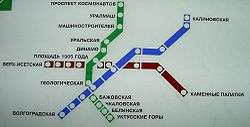Yekaterinburg Metro
 | |
|
A train at Prospekt Kosmonavtov station | |
| Overview | |
|---|---|
| Native name |
Екатеринбургский метрополитен Ekaterinburgskiy metropoliten |
| Locale | Yekaterinburg, Russia |
| Transit type | Rapid transit |
| Number of lines | 1 |
| Number of stations | 9 |
| Daily ridership | 130,000 (daily average, 2012)[1] |
| Operation | |
| Began operation | 1991 |
| Technical | |
| System length | 12.7 km (7.9 mi) [1] |
| Track gauge | 1,524 mm (5 ft) (?) |
The Yekaterinburg Metro (Russian: Екатеринбу́ргский Метрополите́н) is a rapid transit system that serves the city of Yekaterinburg, Russia. The Metro opened on 26 April 1991, and is 12.7 kilometres (7.9 mi) long[1] and serves 9 stations.[1] The Yekaterinburg Metro was the 13th and last metro to open in the USSR.
History
Yekaterinburg, formerly called Sverdlovsk, was always known as the informal capital of the Urals, a natural divide between Europe and Asia, between European Russia and Siberia. The city grew very rapidly because it was an important industrial centre and a transport hub. Plans for a rapid-transit system began in the late 1970s, and in 1980 construction began.
The city's uneven landscape, as well as its layout with a very dense city centre, prompted to combine deep and shallow stations. On 26 April 1991, the sixth Metro of Russia and the thirteenth and last Metro of the Soviet Union, which ceased to exist only a few months later, was finally opened to the public. The economic crisis of the early 1990s rocked the Metro very hard and the first stage encompassed only three stations. However, then Russian president Boris Yeltsin diverted state funds to complete its construction and by 1995 the Metro was doubled in length. Since then, only two extensions have been built.
Timeline
| Yekaterinburg Metro
|
||||||||||
|---|---|---|---|---|---|---|---|---|---|---|
| Prospekt Kosmonavtov | ||||||||||
| Uralmash | ||||||||||
| Mashinostroiteley | ||||||||||
| Uralskaya | ||||||||||
| Dinamo | ||||||||||
| Ploshchad 1905 Goda | ||||||||||
| Geologicheskaya | ||||||||||
| Bazhovskaya | ||||||||||
| Chkalovskaya | ||||||||||
| Botanicheskaya | ||||||||||
| Segment | Date opened |
|---|---|
| Prospekt Kosmonavtov–Mashinostroiteley | April 26, 1991 |
| Mashinostroiteley–Uralskaya | December 22, 1992 |
| Uralskaya–Ploshchad 1905 Goda | December 22, 1994 |
| Ploshchad 1905 Goda–Geologicheskaya | December 30, 2002 |
| Geologicheskaya–Botanicheskaya | November 28, 2011 |
| Chkalovskaya | July 28, 2012 |
Operation
The Metro is a typical Soviet design, which when completed will form a triangle from three lines intersecting in the city centre. The eight stations comprise 12.7 kilometres (7.9 mi) of length and are split between deep and shallow. Of the latter, four are pillar-trispans and one is a single vault (built to Kharkov technology). The deep-level stations include one pylon, one column and two Leningrad-technology single vaults, although one was built to a design making it appear as a single deck. Like all ex-Soviet Metros, the stations are elaborately decorated, although economic hardships prevented the full original designs from being implemented.
The Metro is served by one depot, Kalinovskoye, and 62 cars are assigned to it.
Ridership has improved in recent years. In 2011, the average daily ridership on the Metro was 105,000.[2] By 2012, the average daily ridership had increased to 130,000.[1] This corresponds to an annual ridership in 2012 of approximately 47.45 million people.

Plans
The construction of the Bazhovskaya station which should be between the "Geologicheskaya" and "Chkalovskaya" has been postponed indefinitely.
The first section of the second line with length of 4.5 km should have four stations: "Metallurgicheskaya", "Tatishchyevskaya", "Ploshchad Kommunarov" and "Ploshchad 1905 Goda". Station "Tatishchyevskaya" and "Ploshchad Kommunarov" will be near Central Stadium, which will host the FIFA World Cup 2018 matches. The opening was originally planned in 2018. However, as of May 2013 was completed only pre-development, competition for the design itself was not yet declared, and therefore, the construction time again shifted, and by 2018 the opening is not realistic.[3]
See also
References
- 1 2 3 4 5 МЕТРОПОЛИТЕНЫ РОССИИ за 2012 год [METROS of Russia in 2012]. Новосибирский метрополитен (in Russian). Novosibirsk metro. 2012. Retrieved 2013-09-03.
- ↑ Перевозка пассажиров
- ↑ E1.RU - Вторую ветку метро к ЧМ-2018 построить не успеют
External links
| Wikimedia Commons has media related to Yekaterinburg Metro. |
- Yekaterinburg at UrbanRail.net
- (Russian)/(English) The most full information about Yekaterinburg metro
- (Russian) Popular site
- (Russian) Metroworld
- (German) (Russian) Metrosoyuza
- (French) List, maps and stations of Yekaterinburg metro
- (Russian) metro-ektb.ru
